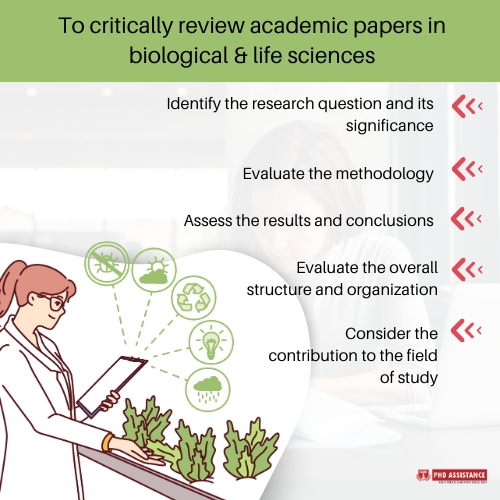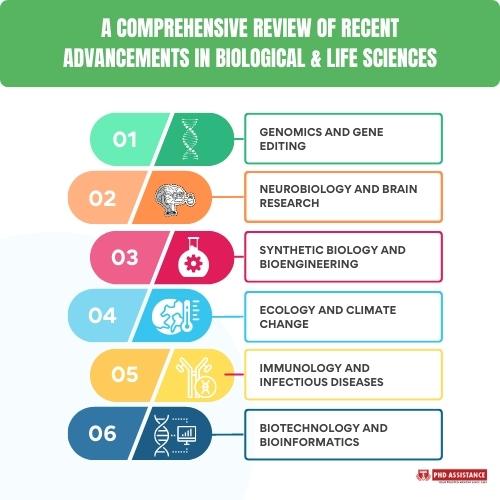How to critically review academic papers in Biological & life sciences
Introduction
A critical literature review (also known as a critique, critical commentary, critical appraisal, or critical analysis) is a deep examination and critique of work. A critical review can be done as a standalone activity or as part of your research and preparation for producing an empirical literature review example. The recommendations below are intended to assist you in critically evaluating a research publication.

To critically review academic papers:
- Identify the research question and its significance: The first step in critically reviewing a research paper is to identify the research question the study aims to address. You should also evaluate the significance of the research question and its relevance to the field of study.
- Evaluate the methodology: The research methodology section of a research paper is critical to its validity and reliability. You should assess the methodology used in the study, including the sampling techniques, data collection methods, and data analysis procedures. You should also evaluate the strengths and weaknesses of the methodology and identify any potential sources of bias.
- Assess the results and conclusions: A research paper’s results and conclusions section should present a clear and concise summary of the findings. You should assess the accuracy and validity of the results and evaluate the strength of the conclusions drawn from the results.
- Evaluate the overall structure and organization: The structure and organization of a research paper are essential to its clarity and coherence. You should evaluate the paper’s overall structure, including the introduction, literature review, methodology, results, and conclusion sections. You should also assess the clarity and coherence of the paper’s argument and evaluate the quality of the writing.
- Consider the contribution to the field of study: Finally, you should consider the research paper’s contribution. This includes evaluating the originality and significance of the research question, the quality of the methodology and results, and the strength of the conclusions drawn from the results.
Examine an academic paper as an example of a critical research literature review. It is essential to evaluate its research question, methodology, results, overall structure, and contribution to the field.
- Check out our sample literature review for the Project to see how the PhD Literature review is constructed.
What is a good topic for a biology research paper?
A good topic for a biology research paper would be “The Impact of Climate Change on Biodiversity and Ecosystems.” This topic allows for an exploration of how global warming and environmental shifts affect species distribution, population dynamics, and ecosystem functioning. It offers opportunities to investigate the underlying mechanisms, potential mitigation strategies, and implications for conservation efforts. Additionally, the topic aligns with current ecological concerns and fosters interdisciplinary research design, making it relevant and impactful in the field of interesting biology research articles.
A Comprehensive Review of Recent Advancements in Biological & Life Sciences
The field of Biological & Life Sciences has witnessed significant progress in recent years due to groundbreaking research and innovative technologies. This review aims to highlight key developments across various sub-disciplines, shedding light on the cutting-edge research that has shaped our understanding of life and living organisms.

- Genomics and Gene Editing: Advancements in genomics and gene editing technologies have revolutionized our understanding of genetics and potential applications in various fields. The emergence of CRISPR-Cas9 has allowed for precise and efficient gene editing, offering unprecedented opportunities in basic research and therapeutic interventions. This section discusses the latest discoveries in genomics, epigenetics, and the ethical considerations surrounding gene editing.
- Neurobiology and Brain Research: With the advent of sophisticated imaging techniques and computational neuroscience, researchers have made remarkable strides in unravelling the complexities of the human brain. This section covers groundbreaking studies in neurobiology, synaptic plasticity, brain mapping, and the connection between neural activity and behaviour. Moreover, it delves into the advancements in brain-computer interfaces and their potential applications in healthcare and neurorehabilitation.
- Synthetic Biology and Bioengineering: The burgeoning field of synthetic biology has enabled scientists to engineer biological systems with unparalleled precision. From creating artificial organisms to synthesizing novel biomaterials, this section reviews the latest breakthroughs in synthetic biological research examples and bioengineering, emphasizing their applications in medicine, agriculture, and environmental conservation.
- Ecology and Climate Change: Climate change and its impact on ecosystems have become pressing concerns. Researchers have dedicated efforts to understand ecological dynamics and devise strategies for conservation and mitigation. This section examines the role of biodiversity, climate modelling, and ecosystem services in addressing environmental challenges and explores how interdisciplinary research is essential in tackling global ecological issues.
- Immunology and Infectious Diseases: In light of recent pandemics, immunology and infectious diseases research have garnered significant attention. Advancements in vaccine development, immunotherapies, and antiviral strategies are highlighted in this section. Additionally, it discusses how immunology intersects with cancer research, autoimmune disorders, and emerging infectious diseases.
- Biotechnology and Bioinformatics: Biotechnology continues to drive innovation across various industries, including healthcare, agriculture, and energy. This section evaluates the latest biotechnological applications, such as biopharmaceutical production, agricultural biotechnology, and biofuel production. Furthermore, it explores the crucial role of bioinformatics in managing and analyzing vast biological datasets.
Remember that critically reviewing academic papers is an iterative process. It takes practice and experience to develop a discerning eye. Over time, your ability to identify strengths, weaknesses, and areas for improvement in research articles will improve, contributing to the advancement of scientific knowledge in the Biological and life science research examples.
- Check out our study guide to learn more about PhD Literature review. Why is a literature review important for a PhD dissertation?
Conclusion
The rapidly evolving landscape of Biological & Life Sciences has transformed our understanding of life and opened new avenues for research and practical applications. This review presents an overview of recent advancements in diverse fields, highlighting the collaborative efforts of scientists worldwide. As we continue to push the boundaries of knowledge, the integration of multidisciplinary approaches will be key to addressing global challenges and improving the quality of life for humanity.
About PhD Assistance
Ph.D. Assistance offers comprehensive dissertation literature review services, utilizing academic sources like journals, textbooks, and newspaper articles to create a research framework, hypothesis, and questionnaire. These experts ensure your research work is ready for journal publication, with access to the latest reference sources. A minimum of 80 references will be used to develop a research framework. Thousands of students have benefited from our services for literature review.
References
- Epstein GL. Preventing biological weapon development through the governance of life science research. Biosecur Bioterror. 2012 Mar;10(1):17-37. PMID: 22455676. DOI: 1089/bsp.2011.0091
- Semilarski, Helin, and Anne Laius. “Exploring Biological Literacy: A Systematic Literature Review of Biological Literacy.” European Journal of Educational Research3 (2021): 1181-1197.
- Weaver, Kathleen F., et al. An introduction to statistical analysis in research: with applications in the biological and life sciences. John Wiley & Sons, 2017.
 Previous Post
Previous Post
